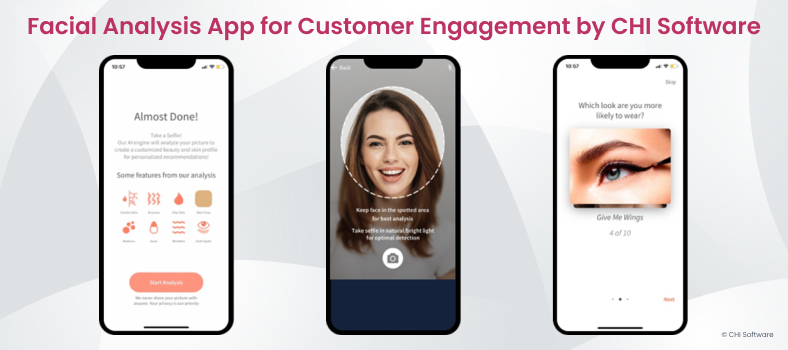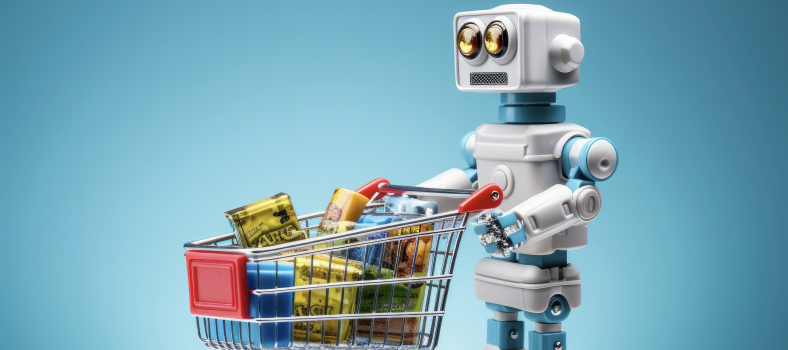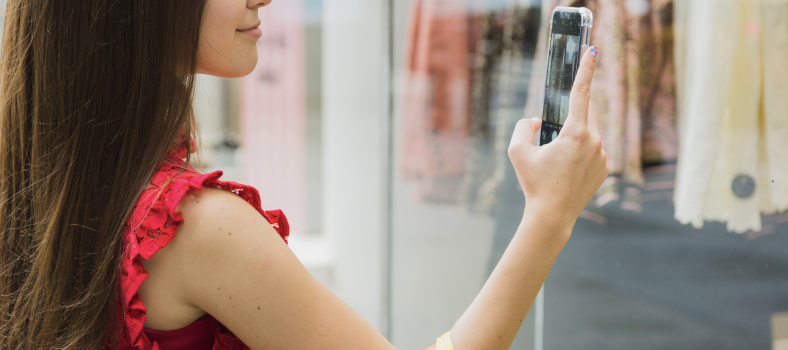Technological advancements of the last year are astonishing! This is especially true when it comes to the abilities of artificial intelligence. What started as narrow-purpose software transformed into a sophisticated system that can provide an answer to almost anything you ask of it.
The retail industry is reaping the benefits of AI, just like many others. There are a variety of solutions retailers can use to make their businesses more efficient, but one solution stands out.
Image recognition technology is a type of AI that can analyze images thanks to deep learning and provide users with actionable information. It also utilizes machine learning for continuous performance growth.
The number of retailers using real-time image recognition is already considerable and continues to grow with each year. According to the statistics, the market size of retail image recognition was 1.4 billion USD in 2020 and, based on forecasts, will grow to 46.7 billion USD by the end of 2024.
So, let’s dive into the specifics of what image recognition for retail can do.
Advantages of Image Recognition in Retail
Image recognition technology brings a lot of value to the retail industry. These benefits are felt both by the business and the customer. Let’s take a look.

Better Customer Experience
Every retailer knows that a better customer experience means better sales. Image recognition positively influences both and can be used in-store or online.
Lowered Reliance on Staff
Retail employees spend much of their time doing two tasks: inventory management and stocking products on shelves. While both are important parts of retail execution, they cut time for other operations. Why not automate them?
Image recognition for retail solutions can help with that. Instead of employees going through isles to see if something needs restocking, AI can do it for them. The same applies to inventory management: image recognition will automatically order restocking if needed.
It’s a win-win for everyone: employees have more time to consult with customers, and the business won’t have to worry about stock levels anymore since AI has got it covered!
What to Consider Before AI Implementation in Retail: 10 Expert Tips
Read more
Data Collection Opportunity
One of the benefits of proper retail execution is insights into consumer behavior. Insights are often the difference between going out of stock and staying ahead of market trends.
Data analysis may sound great as an idea, but as soon as retailers realize the amount of data they possess, they understand that it’s not so easy to do. However, that is not the case for image recognition. Since it’s a fusion of machine learning and computer vision technologies, it can do the job in minutes.
Counterfeit Items Prevention
Researchers estimate that 2 trillion USD worth of counterfeit products are sold each year – just in the US. This is quite a big problem, but image recognition software can help businesses out with tackling it.
AI can detect counterfeit products by comparing them with images of the items in stock. While the same work can be done by humans, AI is more attentive. Additionally, AI-powered cameras in physical shops can detect theft and automatically alert security.
As a result, by adopting image recognition, businesses increase security and protect themselves from lawsuits.
Building AI Chatbots for E-Commerce: What to Consider in 2025
Read more
Virtual Try-On Experience
Every customer would like to know if the product fits their needs before buying it. Unfortunately, the nature of some items doesn’t allow such an option – but the good news is that technology can help.
A combination of machine learning and augmented or virtual reality (AR and VR, respectively) gives customers a “try-before-buy” option. Shoppers will be thankful for this, and it can positively affect sales. One of the critical benefits of image recognition is enhanced security through facial recognition development, which helps retailers identify known shoplifters and prevent fraud.
To summarize, image recognition technology is beneficial for both business and its customers. But how do businesses use it? Let’s talk about it.
The Role of Computer Vision in Business Automation: Insights Based on a Real Case Study
Read more
CHI Software Case Studies: Image Recognition in Retail
We at CHI Software have done our fair share of computer vision software development in the past – so let’s open up our portfolio and look at a couple of projects we’ve done.
Image Recognition for a Beauty Platform
Beauty products are always in demand – but without knowing what works best for a particular person, it’s hard to guarantee customer satisfaction.
Our client recognized this problem and contacted us to create a solution for an AI-powered app that can analyze customers’ facial features and provide product recommendations, as well as a fitting room that will allow users to try on products.
Both of these systems come as separate modules. Let’s cover them.

Recommendation system
Every retail business knows that to stay ahead, it needs to make every customer feel special. One of the best ways to show your business cares is to recommend items specifically catered to customers.
To help make app users feel valued, we created a personalized recommendation system based on image recognition technology. The user takes a selfie and uploads it to the app, which determines facial features and skin type. This analysis is used to generate recommendations catered individually to each user.
The personalized recommendation system has another ace up its sleeve. Our solutions allowed the client to promote and upsell complementary products, generating more profitable sales. After the introduction of this system, our client marked an increase in revenue by 10%.
Fitting room
Online stores can’t provide customers with a sample of skincare or makeup products before buying them. This is an understandable limitation of being an online retailer; however, this leaves customers less satisfied. To fix this problem, we introduced a special fitting room to our solution.
This fitting room is built with a combination of real-time image recognition and augmented reality technologies. The resulting solution allows users to try products virtually. Not only does this fix a problem, but it also lets users experiment with how they want to look, which led to our client’s 10% higher customer retention and engagement.
To learn more about this project and read about features in more detail, you can read our extensive case study. Meanwhile, let’s look at another project where we used image recognition.
A Beauty Retail Mobile App Powered By Image Recognition
When it comes to shopping platforms, most online stores rely on customer shopping history to recommend new products. While this system is reliable, users see it as robotic – since everyone does it.
Our client decided to mix things up a bit. They were looking for someone to create an AI-powered mobile app that could recommend products to customers based on their skin type. Eventually, they found us.

We developed an application based on image recognition that works in three quick steps:
- The user takes a selfie;
- The image recognition system analyzes facial features;
- The system provides users with recommendations based on analysis of their faces.
This system also gives users helpful tips on what item to buy. Both of these features combined create a personalized experience for each user.
Every customer wants to feel special. And what better way to create this feeling than by giving them personalized recommendations? To read more about this project, click here.
Like any coin has two sides, and the same applies to technologies. While image recognition has its benefits, it also has challenges. Let’s talk about them.
Use Cases of Image Recognition Technology in Retail
Now that we have covered all the benefits that image recognition for retail brings, let’s focus on how it’s put to use. We compiled several use cases you might be interested in.

Search by Image
Image recognition helps customers find what they want faster. It works both in-store and online, with the difference that the system will check the store’s inventory instead. Search by image comes in three different flavors:
- Visual search, which allows users to upload an image of an item, and the system will find matching products in the store’s stock;
- Visually similar search, in cases when the store doesn’t have the exact copy but has similar items;
- Personalized product recommendations that analyze which items user likes and presents them with a variety of complementary items
Product Tagging
For a better customer experience, a lot of businesses in the retail sector use tags for easier item searches. However, these tags need to be added manually, and that can take employees a lot of time – but not with image recognition! The system can automatically add tags to products by analyzing its image. This way, businesses save time for their employees, and customers have an easier time searching for what they want.
AI in E-Commerce: 16 Use Cases for Stunning User Experience
Read more
Planogram Compliance
A planogram is a scheme of optimal product placement for increased sales. Item placement can be another time-consuming task for employees, but image recognition is here to help once again! It scans the store shelves, detects products and classifies them based on retail execution and stock-keeping unit (SKU) options. Then, it ensures planogram compliance by matching the current placement to the desired one notifying employees if there are mismatches.
Product Audits
Traditionally, retail audits are done by humans. This method has two issues: it is time-intensive and convoluted, making employee workloads heavier and leaving a lot of room for human error.
Unlike humans, AI is programmed to always be attentive and not lose track of anything. This is why, by using image recognition to conduct audits, retail stores can get more consistent and valuable data.
Self-Checkout Systems
Customers tend to prefer self-checkout options compared to the traditional cashier experience. There are two main ways businesses implement self-checkout.
The first one is placing machines where customers can scan products themselves. The second one is more interesting since it relies on image recognition-powered cameras to detect which customer took what item and automatically deduct the payment from their linked account.
AR Systems
Visualization of items in real life helps customers better understand whether they want it or not. This results in better customer satisfaction and positively reflects on sales.
Image recognition for retail solutions solves this problem. By combining augmented reality with item images, the system can model how a product will look on a customer or in their interior.
What use case would you like to implement? Let's decide on the project's scope together.
Drop us a line
Smart mirrors
Out of several ways businesses can use this technology, one stands out the most – smart mirrors. Imagine a mirror that can recommend clothes based on what the customer is wearing at the moment. Or skincare products by just looking at their face and determining skin type.
This is what a smart mirror is. Needless to say, customers love how they provide personalized recommendations and look like something out of science fiction.
Obstacles of Image Recognition in Retail and How To Overcome Them
There are two challenges a business might encounter: technological limitations and hardware limitations. While hardware limitations are easy to overcome by providing sufficient machines, technological limitations are in a different ballpark. Let’s discuss what to expect and solutions to the potential hurdles in execution.

Partially Hidden Objects
Retail image recognition is great at object detection. However, to properly detect an item, it needs to have a clear view. This might be a problem in real life since shops tend to have customers, and they can obstruct the view of items, causing technical issues. This problem is hard to overcome, but it’s not impossible. Using enhanced computer vision AI models is the answer.
Camera Angles
Picture this: your store has a shelf with items and a camera that sees the shelf from an angle. Items are visible, but they appear distorted due to camera placement. This might cause the image recognition system to fail to detect items on the shelf. But why?
To recognize an item, an image recognition system must have the item’s visual data. Usually, retail solutions with image recognition are trained on product images that cover all sides of the product. However, in the real world, cameras often will see items from unconventional angles. To fix this problem, you need to diversify the image recognition dataset with pictures of the product from different angles.
Shape Change
Some store items may change shape over time. A good example is folded/unfolded clothes. This might confuse the image recognition system if it wasn’t trained to recognize the changed shape of an item. By diversifying your dataset with images of the item’s changed shape, you can mitigate this problem.
Ready-Made or Custom AI Solutions For Retail? Pros & Cons
Read more
Lighting Conditions
Light quality tends to change throughout the day. While in most cases this isn’t a problem, some may experience troubles with item detection due to overexposure to light and the use of insufficient quality cameras. Luckily, image normalization can fix this problem.
A Mess in the Background
Anyone can find a needle on the table. Not many can find a needle in a haystack. The same principle applies to image recognition. The system can detect an item with an empty background. In the real world, however, the likelihood of an empty background is questionable. Image segmentation solves this problem.
These challenges might look menacing, but when it comes to AI models, there’s a solution that almost always works. By providing an image recognition system with a diverse dataset that covers weird angles of items, items on cluttered backgrounds, different lighting levels on items, etc., you can solve all of these problems. The diverse dataset of product images leads to better outcomes, allowing retailers not to worry about these challenges.
Conclusion
Image recognition can be a godsend for retail operations, as it effectively optimizes work and provides retailers with growth opportunities.
For customers, it provides a better experience in-store and online thanks to personalized recommendations, product tagging, and a faster sales process.
Image recognition for retail is almost perfect since most of its issues can be mitigated if you have the proper expertise.
Luckily, we at CHI Software have expertise in developing solutions using image recognition technology. If you’re interested in adopting this technology into your business, we are an image recognition software development company that is here to make your dreams come true!
FAQs
-
What are the primary roles of image recognition in eCommerce?

Image recognition changed customer experience forever. Primarily, it’s used for features such as:
- Search by image: the user uploads an image of a desired product, and the system matches that image with available products;
- Product tagging: instead of tagging items personally, image recognition can automatically do that based on its analysis;
- Product audits: image recognition can match products you have in the inventory with the online store stock;
- AR systems let users try out products virtually to gain a better understanding of what products look like.
-
Which free image recognition software stands out as the best?

Most enterprise companies provide a free version of their image recognition solutions. For business purposes, you should look into software such as:
- Google Cloud Vision can provide you with all image recognition capabilities with limited uses per month;
- Microsoft Azure Computer Vision comes with an additional image tagging feature;
- Amazon Rekognition can be customized to meet business needs.
-
Which image recognition startups have achieved the most success?

Out of numerous startups that tried to make image recognition technology, a couple stand out as the most successful:
- Clarifai built a model for global image recognition that is primarily used for tagging and filtering. Their system is considered to be highly accurate;
- AnyVision primarily focuses on object detection and facial recognition. They made a name for themselves working with security and financial sectors to detect fraudulent activities;
- DeepVision provides its customers with image recognition solutions that are primarily used by retail and automotive sectors. Their system can automatically extract valuable information from images.
About the author
Alex is a Data Scientist & ML Engineer with an NLP specialization. He is passionate about AI-related technologies, fond of science, and participated in many international scientific conferences.
Rate this article
22 ratings, average: 4.5 out of 5







